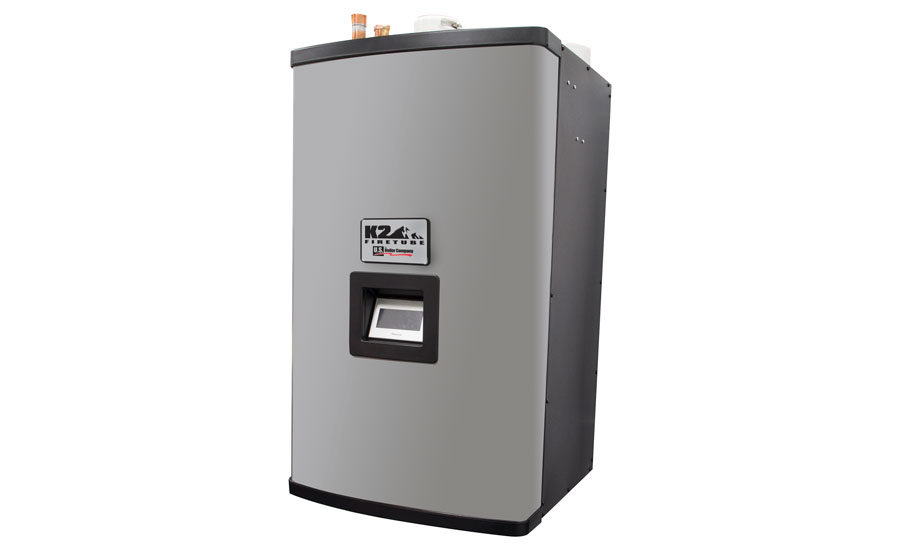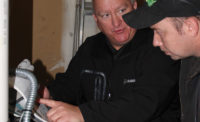LAS VEGAS – Early last year, the U.S. Department of Energy (DOE) issued a final rule amending the minimum efficiency standards for residential boilers, which will go into effect Jan. 15, 2021. In addition, the DOE amended its test procedure for residential boilers, which increases the amount of work manufacturers have to do in order to develop and improve new products, said Michael Boyd, product manager, Weil-McLain.
“There is currently a lot of activity in residential and commercial boiler regulations,” said Boyd. “The changes in test procedures don’t have any effect on contractors, but the increasing efficiency regulations beyond 2017 will make it difficult for contractors in certain locations.”
RULES, COMPETITION
The new minimum efficiency standards may make the most difference where the replacement product is a Category I vented appliance, said Boyd.
“This situation occurs a lot when boilers and water heaters are common vented or when the design and construction of the building make it difficult to run new vent systems if there isn’t a replacement boiler that can utilize the existing building infrastructure,” he said.
The boiler market is also becoming very competitive within the high-efficiency segment as more companies develop or import products, said Boyd. To that end, Weil-McLain introduced the AquaBalance™ combination boiler, which combines the warmth of high-efficiency space heating and the convenience of on-demand domestic hot water. “An all-in-one, elegant, affordable, and space-saving package, the AquaBalance boiler exceeds Energy Star certification requirements at 94.4 percent AFUE and is built with the latest stainless steel, titanium-infused heat exchanger technology.”
With a full 155,000-Btu input capacity, AquaBalance has plenty of power for whole-house domestic water heating, said Boyd. “It provides a constant supply of hot water by producing up to 4 gallons per minute (gpm). By making the switch from a separate boiler and hot water tank to the AquaBalance combi-system, the installation process is streamlined. Fewer pipes and less connection points translate into less time.”
Recent DOE initiatives mandating higher efficiency boilers for new installations and retrofits are definitely a concern, as is competition from other heating sources, such as variable refrigerant flow (VRF) systems, heat pumps, and other similar technologies, said Brian Huibregtse, product and application engineer, packaged boilers, Cleaver-Brooks. “Changes in emissions and energy regulations could either drive more sales or reduce them, depending on the shift that occurs. Increasing foreign competition in the U.S. market also could be a factor.”
Existing boiler plants continue to age, which should encourage the growth of replacement boilers, said Huibregtse. “Replacement boilers are a growing market as customers continue the shift to high-efficiency and high-mass boiler designs for energy savings and longevity.”
The Cleaver-Brooks Tubeless (CBT) boiler is designed to fill that need as the high-efficiency, compact, vertical steam unit is ideal for high make-up water applications, such as humidification and food processing, said Huibregtse. “The CBT burns natural gas or propane fuel and achieves up to 84 percent fuel-to-steam efficiency with a 4:1 turndown capability. At 99 percent steam quality, the CBT produces excellent dry-quality steam for both high- and low-pressure systems and is available in five sizes from 10 to 30 horsepower.”
Low-priced competitors in the residential boiler market are forcing all manufacturers, distributors, and contractors to better understand their customer priorities and increase product/service value, said David Hansen, residential product marketing manager, U.S. Boiler Co.
“We’re very optimistic about 2017 because business conditions and channel inventory have improved, and we have filled a few key gaps in our cast-iron and condensing product lines with high-performance, high-value new products.”
Two of those new products are the K2FT firetube and X-C watertube high-efficiency condensing boilers. “These feature significant enhancements, including high firing rate turndown, new boiler sizes, and flexible mounting configurations,” said Hansen.
Increased commoditization of light commercial boilers and smaller sizes is definitely an issue, said Joel Southwell, vice president of sales and marketing, Fulton Co. “This is driving some manufacturers to design larger models of boilers to increase market share for sizes above 1 MMBtuh. Fulton has long been focused on larger commercial size ranges, and our emphasis has been on the development of new technology that improves upon the shortcoming of existing boiler designs. We’re improving efficiency, shrinking footprints, and removing obstacles to heat exchanger longevity.”
An example of that new technology is the Endura+ (EDR+) ultra-high-efficiency condensing boiler. Featuring up to 99 percent efficiency, 15:1 turndown, and O2 compensation, the Endura+ can adjust oxygen levels in real time to maximize combustion efficiency. “The most novel feature is that the boiler utilizes a new, patent pending design that eliminates longitudinal thermal expansion stress on the heat exchanger. All of the Endura+’s features together mean improved efficiency, decreased installation costs, and longer life expectancy for the boiler,” said Southwell.
ENERGY SAVINGS
Bosch Thermotechnology Corp. introduced its fully modulating Greenstar condensing gas boilers. These wall-mounted and floor-standing boilers (both heat-only and combi models) achieve Energy Star’s Most Efficient rating of 95 percent and are equipped with a pump, pressure relief valve, propane conversion kit, and twin pipe flue adaptor, said Dan Moffroid, director of product management, Bosch Thermotechnology Corp. “Greenstar models are quiet in operation and ideal for heating and domestic hot water applications, including radiant heating with panel radiators.”
The company also featured the new Buderus SSB condensing stainless steel boilers, which consist of eight models in four separate cabinet sizes with inputs ranging from 85-1,024 MBtuh. “The Buderus SSB Series is designed as a modular platform for commonality and familiarity for the installer, which enables quick and easy installation in various applications,” said Moffroid. “Residential and light commercial models are rated at 96 percent AFUE, and all sizes have a turndown ratio of 5:1, delivering precise load matching and ultimate efficiency.”
Consumers are always looking for highly efficient products that can save them money and space, and combination boilers offer the perfect solution, said Jason Fleming, vice president of sales and marketing, Noritz America. “Our new CB Combi delivers hot water to both plumbing and hydronic heating applications and manages to switch between those uses without a perceivable difference in performance on either side. Its 95 percent AFUE makes it an extremely energy-efficient appliance that meets Energy Star Most Efficient standards. And, for the retrofit market, this unit makes so much sense, because one person can install it.”
Delivering up to 9.2 gpm of domestic hot water, the CB Combi features a flow control valve that allows the unit to deliver the maximum possible domestic hot water flow rate at a stable temperature regardless of incoming water temperature, said Fleming.
More and more consumers are requesting high-efficiency equipment, even if the upfront cost is elevated, said Nery Hernandez, product solutions manager, Aerco Intl. “This translates into significant financial savings over the life of the equipment as the high-efficiency solutions pay for themselves in a few short years.”
In response to this trend, Aerco introduced the Benchmark Platinum Series, which features eight models that cover up to 6 MMBtuh and deliver efficiencies as high as 96 percent. “The new Benchmark Platinum solutions combine exceptional levels of performance, reliability, and system monitoring to lower operating costs in a variety of commercial applications,” said Hernandez.
The Benchmark Platinum Series includes dual returns, which enhance the efficiency of these boilers by improving overall system plant efficiency and extending condensing mode operating hours, said Hernandez. “The dual returns allow engineers to leverage diverse load demands specific to a system, so a custom water heating solution can be designed to maximize operating efficiencies. The boilers also feature AERtrim Advanced O2 Trim Technology, which lowers operating and maintenance costs to further improve efficiency.”
Publication date: 2/27/2017
Want more HVAC industry news and information? Join The NEWS on Facebook, Twitter, and LinkedIn today!

















